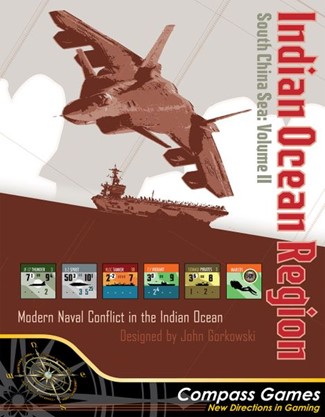
Cover Art
BGG link: /https://boardgamegeek.com/boardgame/258209/indian-ocean-region-south-china-sea-vol-ii
Well it goes to show as we get older we get slower…or something. Its taken a few questions and finally caving and reading the example of play to understand the base concept of this game system. The issue was with the physical flow of things, and tying that back to the wording. But reading the examples made it all crystal clear. When a rulebook has multi page examples of play I tend to skip them, as my hope would be I can grok the process from the rules. Excellent examples here clear up the mis conceptions I developed in my head ‘assuming’ things would work ‘like any other game’. Im a dork.
There are some neat ideas here that given the ranges of weapons platforms in the modern era, very few units actually move [or need to be physically moved] to execute attacks etc. Instead, we use the idea of a focus area delineated by a focus marker and then all units in range or who can illuminate the enemy [spot its signature] can be defined and allocated to that effort. That ‘engagement‘ occurs and is resolved and all units left that are not spent can then execute their own engagements.
Engagements are resolved using a set of strikes usually done in Faction or stealth order.
So for our mini example scenario we have Iranians dedicating hex 1203 as a focus hex for the engagement.
The US forces will not evade as they will want to execute their own engagements in their activation and if they evade they cannot do so.
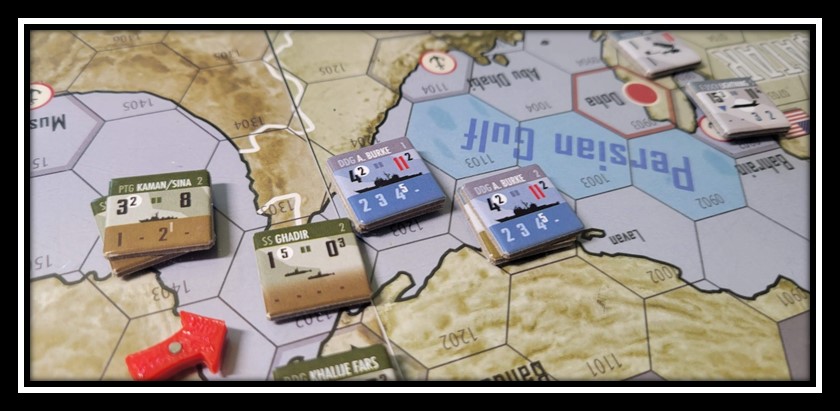
The US navy forces move towards the straits. No one attempt to intervene [intercept].
Air/Sea Combat Phase
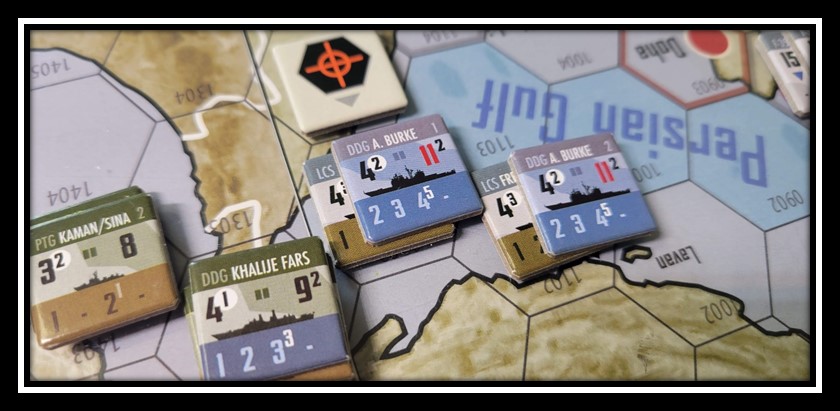
This is the guts of the military side of a turn.
The Iranians have a Sub, a PTG and a DDG formation in the VP location. The two ships can attack the focus hex as they are in range. The US allocates its air and DDG & LCS to the defense also [note it could add the other US ships if they had better area defense but they do not, they could have also chosen to add them I believe into the immediate shoot also. A tactical choice I made, to get more reps in on combat.].
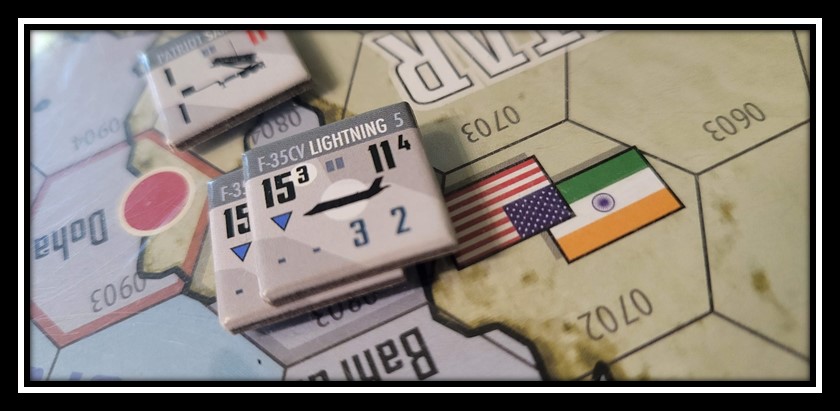
Air goes first, if the Iranians had air, we would resolve that first they do not so we move on.
Anti Ship is next. Using stealth order the US F-35s will go in first. They are under ½ range so no penalties. They hit the PTG. They roll 2d6 and add 3 for the AS strike value for a total of 9. 1 greater than the defense of 8. The PTG formation takes a hit. The other F-35 strikes at the DDG and misses (2)+3 is less than 9.
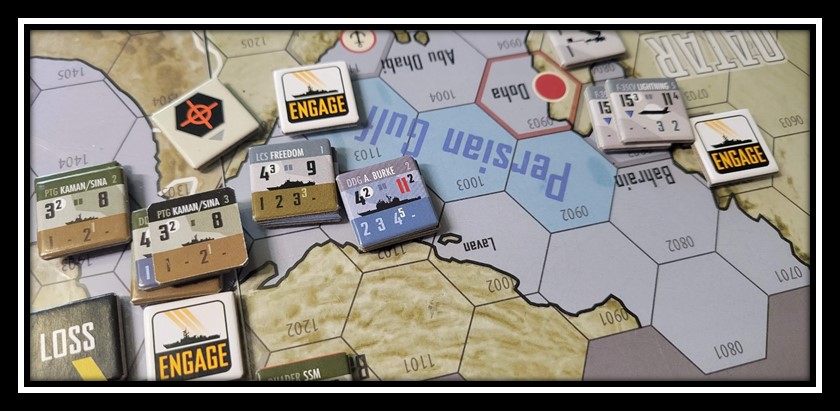
The LCS has a higher stealth rating than all other ships it fires first. 2d6 (8+3) =11 which is 2 greater than the DDG’s defense rating of 9. They suffer two hits. This sinks the DDG!

Now the Iranian PTG and US DDG fight it out simultaneously as they have the same stealth ratings. The Iranians roll 8+2 AS for a 10 at the LCS. The DDG loans its AMD rating of 11 and thwarts the attack. The The US DDG now resolves its attack. Rolling 8 also +4 = 12. For 4 hits. Three is the maximum and the PTG can only take one more so it also sinks. Looks bad for the Iranians.
No doubles were thrown by the US so no low ammo markers are placed.

Now the US can execute an engagement. They have the range to target and can illuminate the Iranian PTG lurking on the horn at 1403. They designate that hex as a focus. The LCS fires first as it has the highest stealth rating but will suffer a minus 1 to the attack due to it being more than 50% of AS range. Same for the DDG.
LCS – 5+3-1=7, the missiles fail to connect. The DDG and PTG fire at the same time. 9+4-1=12 for 4 hits! The PTG shots launch also and streak into the sky even as hell rains down on them. They roll 7-1+2=9, not enough to breach the DDG’s AMD defense of 11!

Boom. We now roll over to the admin phase.
Turn 2.
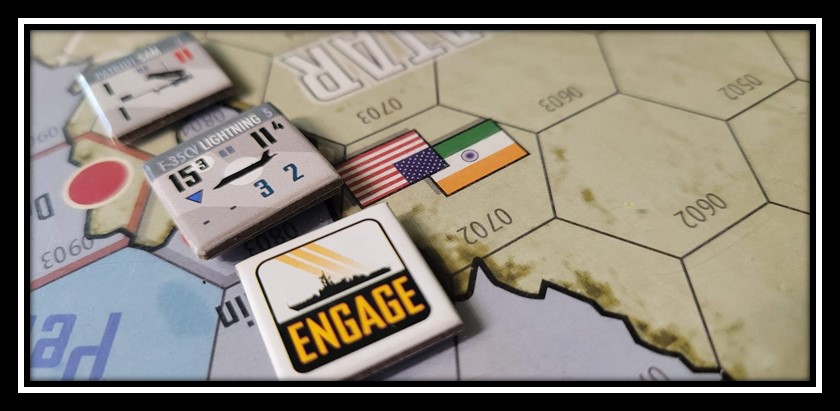
The DDG’s advance into the straits to hunt down the 2 sub units. The Iranians try to intervene but fail their rolls. The US moves the LCS’ units in also.

The US are attacked by subs first, per sequence of play.
Both one attack pack sinks a DDG. The other misses. With Torpedo strikes we use a flat defense of 8 [ I think]. They roll 12 and 8 net inclusive of the attack factors.
The Quader SSM unit fires also. But not before the US Air gets its shots in. They demolish the Anti Ship missile platform in Bandar Abbas with precision strikes. 
Now the remaining ships in the US taskforce enter into anti sub mode. They all roll. The DDG targets sub #1. 8+4 =12 against a defense of 8. Means 4 strikes, for a net max of three. Down to Davy Jones locker and no virgins for them.
The last two LCS sink the remaining sub formation. 7+3=10 for 2 hits, just enough, as the other LCS whiffed their roll with doubles and went low ammo with a 2. That means our scenario is over with no enemy units in the FEBA! Or target zone or w.e.
Ok. What did we just learn?
Modern naval combat is definitive and deadly. Subs are always a threat. The notion of extended defensive networks is pretty nifty, where top flight units can ‘loan’ their defense to the weaker craft.
What I’m seeing is a pretty intuitive set of game play with what would arguably be called an abstract system of combat. One thing that is notable is the lack of ‘tactical’ finesse required. 
There were other choices that could have been made for the attacks, and engagements, the ground based SSM’s probably should have been used in the first strike for example. It would be interesting to see how the idea of over whelming anti ship attacks can overload defenses of these platforms. Can that be represented in more detail I wonder. There is a bit of a static nature to the game, which in the Fleet series seems be a key difference. That may just be scenario differences however.
Next up in a few weeks we will look at a larger scenario and cover the political aspects of the games system as well as a bit of ground warfare. Pretty solid so far.